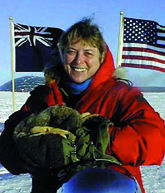 |
|
| Dr. Jerri Nielsen at the South Pole. (Below) In the subfreezing dark, ground crew from the Amundsen-Scott station had only a few minutes to find and recover emergency equipment. | |
June is the dead of winter at the National Science Foundation's Amundsen-Scott South Pole Station-41 people inside the dome, temperatures averaging 80 degrees Fahrenheit below zero, 60-mile-per-hour winds, and around-the-clock total darkness outside. The nearest human settlement is 800 miles away, and most years nobody gets in or out between February and November.
On June 17, 1999, NSF headquarters announced that a 47-year-old woman, later identified as Dr. Jerri Nielsen, the station's physician, had discovered a lump in her breast. After lengthy consultations with medical experts in the United States over the next eleven days, a call went out for an emergency airlift of drugs and diagnostic tools.
Chuck McParland of Berkeley Lab's Information and Computing Sciences Division immediately volunteered the Lab's assistance. Within days Lab personnel had assembled computer communications software and hardware, critical for real-time conferences and exchanges of medical images with the South Pole.
 |
|
 |
|
 |
|
 |
|
 |
|
| In the subfreezing dark, ground crew from the Amundsen-Scott station had only a few minutes to find and recover emergency equipment. | |
"We specified the right equipment for establishing the link and helped track down the necessary equipment," McParland says, noting that colleagues at Argonne and Oak Ridge helped locate cold-proof equipment in ready-to-go condition, including rugged digitizing cameras for use with microscopes. Berkeley Lab donated two noise-canceling headsets. An Air Force C-141 Starlifter from Washington State carried six 350-pound pallets of medicine and machinery-plus a bonus bundle of fresh vegetables and mail-to the South Pole station. The cargo jet had to refuel in mid-air on the last leg of the 6,375-mile round trip from New Zealand, approach the station at its challenging 10,000-foot altitude, and find a drop zone marked out by blazing oil drums in the howling darkness.
On July 11 the big plane buzzed the station twice at 190 miles per hour, 700 feet off the ice. Slowed by parachutes, the pallets slammed home at 60 miles per hour. Flashing strobes and glow patches on the bundles quickly led the ground crew to the first five, but the cold instantly extinguished the marker lights and (with trips outside limited to seven minutes at a time) it took an hour and a half in the sub-freezing night to find the last package.
"Only one piece didn't make it," says McParland, "a 300-pound Siemens ultrasound machine that shattered when it hit. But there was a backup for everything." Within two days, the Polaroid microscope digitizers were storing images of tissue samples with million-pixel resolution and 10 bits of color. Over the next several months, these were shared during regular videoconferencing sessions between Dr. Nielsen at the Pole and a medical panel based in the Midwest, who monitored her progress.
On October 16, weeks earlier than any previous flight to the Pole, a ski-equipped C-130 from the New York Air National Guard, which provides logistical support to the U.S. Antarctic program, took advantage of minus-60-degrees-F weather (just two degrees above the Air Force's safety minimum) and landed at the Amundsen-Scott station.
Dr. Nielsen was soon on her way home. Since her return to the United States, the NSF has not disclosed her whereabouts or condition. Without the remote-collaboration equipment assembled by Berkeley Lab volunteers, the level of her care during the long Antarctic winter could not have been as knowledgeable, swift, or sophisticated. - end -
| < Research Review | Top ^ | |